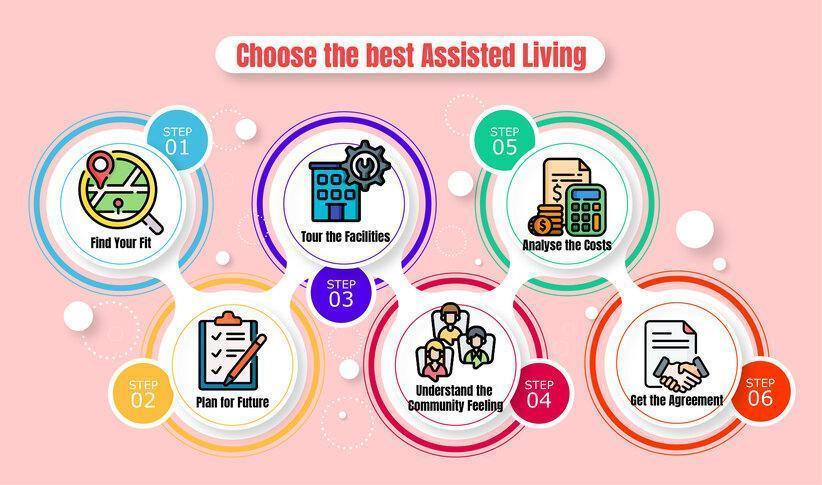Article Contents
Introduction
Time isn’t anyone’s friend. Everyone knows that this is true, but the effects of time truly dawn on us when we realize that we’re growing old. We find ourselves depending more and more on family members to go about our day. It shouldn’t come as a surprise when the doctor suggests an assisted living community. You will need to choose a proper assisted living community to live in.
This isn’t because you’re a burden on the family or because your loved ones are tired of taking care of you. Assisted living is a great option if you’re looking for stability and better care. If you can afford senior care facilities, then we strongly suggest this. Why? Because living in such a community can make your life easier. It ensures that your family can visit you at any time without worrying.
All can only be easily done by living in the right assisted living community. In this article, we’re going to help you choose the perfect assisted living community for you.
Understand the 5 Different Types of Communities
Before we jump into the specifics of an assisted living facility, we have to ensure that you know the various options available. Most seniors and their families don’t know the kinds of senior care facilities. So, before going further, we decided to explain what kind of health care communities you can join.
You must understand the difference between the many types of communities available.
1. Assisted Living
Assisted living is perfect for anyone who needs assistance with activities of daily living. But this does not mean that they need constant assistance like those in a nursing home. Assisted living facilities can be big or small. If you want, you can find something that has a lot of people. If you don’t want that, you can choose a smaller place. It’s all up to you.
Assisted living residents usually live in their apartments or rooms. They have access to many services, including
- three meals a day;
- assistance with personal care;
- help with medications, housekeeping, and laundry;
- 24-hour supervision, security, and onsite staff; and
- social and recreational activities.
Exact arrangements vary from state to state.
2. Continuing Care Retirement Communities (CCRCs)
CCRCs offer the entire deal, making them quite popular. From independent to assisted living to 24-hour nursing care services. All of this is possible under one roof with CCRCs! Residents pay an entry fee and an adjustable monthly rent in return for care for the rest of their lives.
Nursing and hospital facilities are often located themselves. But this can- naturally- wary from place to place. In addition to healthcare, CCRCs also typically provide:
- food,
- housekeeping services,
- transportation services,
- socialization options,
- maintenance services, and
- 24-hour services
Just like assisted living facilities, the size of this community depends on you. You can pick a large CCRC or a small one.
3. Independent living
Independent living should not be defined in terms of living on your own. However, it’s not uncommon to see people mix these two things. So, we’re going to set the record straight.
Independent living refers to being able to live on your own without any outside interference. However, you will still have the option of having a nurse or staff member help you along with different resources for independent living.
Independent living isn’t easy. It certainly isn’t for everyone. But you can easily make due if you’re looking for something that won’t hinder your independence.
4. Nursing Home
A nursing home is a place for seniors who don’t need to be at the hospital for days but can’t be cared for at home. Most nursing homes have nursing staff available 24 hours a day in case of emergency.
Most nursing homes are set up like a hospital. There’s a hospital room-style bedroom for patients; staff provides medical care. They also keep a check on your medication, as well as physical, speech, and occupational therapy.
However, not all nursing homes are like this. Some believe that having a hospital-like setting can be overwhelming. So they prefer a more “homely” look. Such nursing homes won’t have a fixed day-to-day schedule, and kitchens are open.
The guide to choosing a nursing home depends solely on the residents’ taste.
5. Home Care
Home care makes it possible for seniors to age in peace. Instead of moving to a facility away from their home, seniors can live at their homes.
Home health care services make daily living more protected and more enjoyable. This allows seniors to spend their golden years in home comfort.
Home care services are also called non-medical care or companion care. It’s similar to what’s offered at an assisted living facility. The exception is that you continue living in your own home.
Find the Right Fit for Yourself
Transitioning into an assisted living community is like moving to a new home. At the same time, it isn’t too different. After all, every senior goes through this at some point. It can still be very overwhelming. It’s not the most frightening time of your life, but you can feel a bit overwhelmed.
The best way to deal with this change is by creating a plan to ensure that you’ve got everything sorted. This way, you will be able to stay organized. It helps ensure you don’t miss any important details while you’re on the hunt for a new place to stay.
According to the National Center for Assisted Living (NCAL), assisted living residents are older than they ever were.
Ask for a list of activities offered at the facility. See if there’s something that caught your attention. Assisted living facilities should have stimulating activities that encourage purpose and connections.
So, make sure that there are a bunch of activities you can enjoy. It doesn’t have to be something you’ve partaken in for years- it could be something you’ve never taken part in. But it’s super important to ensure that you’ve got a list of activities you can enjoy in the long run.
At this point, you must look at two very important things: physical exercise options and residential councils.
People often underestimate these two things. Trust us. You will want a variety of exercises and a general meeting. This way, you can express your thoughts and complaints.
Plan for Your Future
Assisted living communities to take in seniors with mild cognitive impairment or early-stage Alzheimer’s. As the condition progresses, said senior is then transitioned into a memory care area. This minimizes disruption at a difficult time but is a higher and costlier care level.
Suppose you have Parkinson’s or another chronic disease. In that case, it is wise to check:
- how much care can be provided in the area,
- what that additional care will cost, and
- other residents with similar conditions.
Make the Most of Your Visits
When you go on your visits, it is wise to meet with the staff and take a complete tour at the very least, sampling the meals as you go too. Ask as many questions as possible through the local AAA. Don’t hesitate to ask for contact information. You can reach out to them later if anything comes to your mind.
You can also try a spontaneous night visit. It will be quite beneficial to know all about the night staff and how things are looked after at night.
This is very important as you might need special care at night. So, it is important to ensure that the night staff is as well-equipped and attentive as the day staff.

Why Do These Things Matter?
Of course, you might be wondering why we’ve included so much information in this blog post. After all, it’s given that you’re going to do your research. So, you’re going to refer to your own needs when finding an assisted living facility for yourself.
Even though this is common knowledge, it’s no surprise that people forget certain things.
How many times have you moved into a rented or purchased place and realized that it’s not what you wanted? Of course, in such situations, it’s easy to make adjustments that will please you.
But you don’t have that luxury in an assisted living program. So, be careful that you’ve got everything sorted.
Get a Tour of the Facility
Experts say that the most important part of making a decision is listening to your gut instincts. Even beautiful facilities with huge advertising budgets can be cold, dreary places. If you feel as though you don’t like the facility, don’t go for it.
The tour itself can be a major determinant in your decision to stay at a facility or not. Therefore, most assisted living centers do their best to put their best foot forward. You must also ensure that this is the case as you go on a tour and proceed accordingly.
While you want to look at the best parts of the center, you also want to understand their shortcomings to ensure that your time there is great.
Get a Feel for the Community
While you’re walking around, don’t worry about checking things off. Instead, pay attention to what you’re seeing, hearing, smelling, and feeling in each of the spaces. Try to talk to different residents and staff members, not just the director of marketing. This will help you get a complete idea of what the community is really like. While on tour, keep an eye out for the following:
- Common spaces
- Residents’ living spaces
- Food
- Activities
These are very important for you as you will be living here for quite a while so you must ensure no compromise.
Make Sure that the Cost Is Right
Many people believe assisted Medicare covers living. About 57% of people surveyed said they plan to rely on Medicare to help pay for any senior care they might need. Yet, while your health insurance and pharmaceutical coverage continue after moving to such a facility. Medicare typically doesn’t pay for two things:
1. The rent of the facility itself.
Most assisted living residents pay for assisted living out of pocket or help from children or other family members. You must, therefore, ensure that your finances are in order so that you can easily pay for this in the long run.
2. Get the agreement in order
Now, after you’ve shortlisted some assisted living programs, you may begin to look over the agreement paper. It is strongly recommended that you check everything written in the agreement contract.
As you will be living there, you must ensure that everything is mentioned in this part. From the staff-to-resident ratio to meal rotation, monthly expenditure, and future increases.
Be extra cautious when reading about the facility’s plan for emergency health care. Is there an ambulance on standby? What hospitals do they have agreements with? Everything is mentioned here clearly.
Some communities also have an ‘exclusionary clause’ where you can’t stay if you don’t have insurance. Furthermore, Medicaid is accepted everywhere either. You should be aware of this situation upfront.
– find the right fit
– plan for future
– visit the communities
– check the services
– get a feeling of the community
– think about the cost
Checklist for choosing assisted living community:
Conclusion
When it comes time to choose an assisted living community, it’s important to do your research. Compare the cost, services, and amenities of different communities to find the best fit for your needs. Be sure to tour the facilities and ask questions about the staff and the care that will be provided. Trust your gut – if something doesn’t feel right, it probably isn’t.
You can also reach out to our website to find out differences among senior living options.
Frequently Asked Questions
What is a community fee for assisted living?
The community fee is a one-time payment that seniors make at move in to cover the cost for preparing their apartments. It ensures that the living space is clean before you move in. The fee range can be $1,000-$5000 or more. This fee is normally non-refundable.
Are assisted living facilities community-based or community-oriented?
Assisted living facilities can be either community-based or community-oriented. Community-based facilities are those that are located within a specific community and offer services or socialization options specific to that community. On the other hand, community-oriented facilities emphasize actively engaging with the local communities to create a sense of shared identity and purpose.
How are assisted living communities regulated vs. nursing homes?
Assisted living communities are typically regulated by the state in which they are located. On the other hand, nursing homes are typically regulated by the state and federal governments. Assisted living communities are loosely regulated compared to nursing homes. Nursing homes are also more highly scrutinized, with regular inspections.

